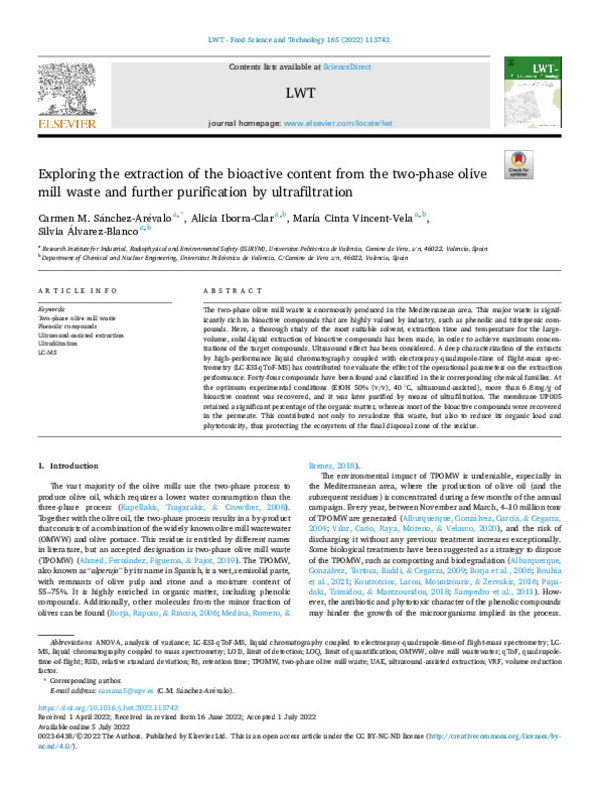JavaScript is disabled for your browser. Some features of this site may not work without it.
Buscar en RiuNet
Listar
Mi cuenta
Estadísticas
Ayuda RiuNet
Admin. UPV
Exploring the extraction of the bioactive content from the two-phase olive mill waste and further purification by ultrafiltration
Mostrar el registro sencillo del ítem
Ficheros en el ítem
| dc.contributor.author | Sánchez-Arévalo, Carmen María
|
es_ES |
| dc.contributor.author | Iborra Clar, Alicia
|
es_ES |
| dc.contributor.author | Vincent Vela, Maria Cinta
|
es_ES |
| dc.contributor.author | Alvarez Blanco, Silvia
|
es_ES |
| dc.date.accessioned | 2023-05-29T18:02:48Z | |
| dc.date.available | 2023-05-29T18:02:48Z | |
| dc.date.issued | 2022-08-01 | es_ES |
| dc.identifier.issn | 0023-6438 | es_ES |
| dc.identifier.uri | http://hdl.handle.net/10251/193714 | |
| dc.description.abstract | [EN] The two-phase olive mill waste is enormously produced in the Mediterranean area. This major waste is significantly rich in bioactive compounds that are highly valued by industry, such as phenolic and triterpenic compounds. Here, a thorough study of the most suitable solvent, extraction time and temperature for the largevolume, solid-liquid extraction of bioactive compounds has been made, in order to achieve maximum concentrations of the target compounds. Ultrasound effect has been considered. A deep characterization of the extracts by high-performance liquid chromatography coupled with electrospray-quadrupole-time of flight-mass spectrometry (LC-ESI-qToF-MS) has contributed to evaluate the effect of the operational parameters on the extraction performance. Forty-four compounds have been found and classified in their corresponding chemical families. At the optimum experimental conditions (EtOH 50% (v/v), 40 degrees C, ultrasound-assisted), more than 6.8 mg/g of bioactive content was recovered, and it was later purified by means of ultrafiltration. The membrane UP005 retained a significant percentage of the organic matter, whereas most of the bioactive compounds were recovered in the permeate. This contributed not only to revalorize this waste, but also to reduce its organic load and phytotoxicity, thus protecting the ecosystem of the final disposal zone of the residue. | es_ES |
| dc.description.sponsorship | Funding Grant CTM2017-88645-R, funded by MCIN/AEI/10.13039/501100011033 and by ERDF A way of making Europe. Additionally, the grant PRE2018-08524 was funded by MCIN/AEI/10.13039/501100011033 and by ESF Investing in your future. Funding for open access charge: CRUE-Universitat Politècnica de València. | es_ES |
| dc.language | Inglés | es_ES |
| dc.publisher | Elsevier | es_ES |
| dc.relation.ispartof | LWT - Food Science and Technology | es_ES |
| dc.rights | Reconocimiento - No comercial - Sin obra derivada (by-nc-nd) | es_ES |
| dc.subject | Two-phase olive mill waste | es_ES |
| dc.subject | Phenolic compounds | es_ES |
| dc.subject | Ultrasound-assisted extraction | es_ES |
| dc.subject | Ultrafiltration | es_ES |
| dc.subject | LC-MS | es_ES |
| dc.subject.classification | INGENIERIA QUIMICA | es_ES |
| dc.title | Exploring the extraction of the bioactive content from the two-phase olive mill waste and further purification by ultrafiltration | es_ES |
| dc.type | Artículo | es_ES |
| dc.identifier.doi | 10.1016/j.lwt.2022.113742 | es_ES |
| dc.relation.projectID | info:eu-repo/grantAgreement/AEI//PRE2018-085245//AYUDA PARA CONTRATOS PREDOCTORALES PARA LA FORMACION DE DOCTORES-SANCHEZ AREVALO, CARMEN. PROYECTO: IMPLEMENTACION DE TECNOLOGIA DE MEMBRANAS PARA LA VALORIZACION DE LOS COMPUESTOS FENOLICOS PRESENTES EN LAS AGUAS RESIDUALES/ | es_ES |
| dc.relation.projectID | info:eu-repo/grantAgreement/AEI//CTM2017-88645-R-AR//IMPLEMENTACION DE TECNOLOGIA DE MEMBRANAS PARA LA VALORACION DE LOS COMPUESTOS FENOLICOS PRESENTES EN LAS AGUAS RESIDUALES DE LA INDUSTRIA DE PRODUCCION DE ACEITE DE OLIVA/ | es_ES |
| dc.rights.accessRights | Abierto | es_ES |
| dc.contributor.affiliation | Universitat Politècnica de València. Escuela Técnica Superior de Ingenieros Industriales - Escola Tècnica Superior d'Enginyers Industrials | es_ES |
| dc.description.bibliographicCitation | Sánchez-Arévalo, CM.; Iborra Clar, A.; Vincent Vela, MC.; Alvarez Blanco, S. (2022). Exploring the extraction of the bioactive content from the two-phase olive mill waste and further purification by ultrafiltration. LWT - Food Science and Technology. 165:1-12. https://doi.org/10.1016/j.lwt.2022.113742 | es_ES |
| dc.description.accrualMethod | S | es_ES |
| dc.relation.publisherversion | https://doi.org/10.1016/j.lwt.2022.113742 | es_ES |
| dc.description.upvformatpinicio | 1 | es_ES |
| dc.description.upvformatpfin | 12 | es_ES |
| dc.type.version | info:eu-repo/semantics/publishedVersion | es_ES |
| dc.description.volume | 165 | es_ES |
| dc.relation.pasarela | S\473015 | es_ES |
| dc.contributor.funder | AGENCIA ESTATAL DE INVESTIGACION | es_ES |
| dc.contributor.funder | European Regional Development Fund | es_ES |
| dc.contributor.funder | Universitat Politècnica de València | es_ES |
| dc.subject.ods | 12.- Garantizar las pautas de consumo y de producción sostenibles | es_ES |








